Brandon.plubell 03:26, 9 November 2009 (UTC)
Part 1 - Use Laplace Transformations
By Brandon Plubell
Problem Statement
Find the equation of motion for the mass in the system subjected to the forces shown in the free body diagram. The inclined surface is coated in 1mm of SAE 30 oil.
Initial Conditions and Values
- A is the area of the box in contact with the surface
- g is the gravitational acceleration field constant
- bt is the thickness of the fluid covering the inclined surface
- μ is the viscosity constant of the fluid
- m is the mass of the box
- k is the spring constant







Let the initial conditions be


Force Equations
The sum of the forces in the x direction yields the equation


Where


To make the algebra easier, let

Then, from the sum of forces equation


Laplace Transform



If we let  be 0 and rearrange the equation,
be 0 and rearrange the equation,


The above is the transfer function that will be used in the Bode plot and can provide valuable information about the system.

Inverse Laplace Transform
Since the Laplace Transform is a linear transform, we need only find three inverse transforms. All of the these have complex roots, since  . Because I am not yet comfortable finding the inverse with complex roots by hand, I used a laplace transform program for the TI-89.
. Because I am not yet comfortable finding the inverse with complex roots by hand, I used a laplace transform program for the TI-89.
![{\displaystyle {\mathcal {L}}^{-1}\left\{{\frac {1}{s\left(s^{2}+{\frac {\lambda }{m}}\,s+{\frac {k}{m}}\right)}}\right\}=e^{{\frac {-1}{6}}\,t}\,\left[{\frac {-9}{40}}\cos {\left({\frac {{\sqrt {159}}\,t}{6}}\right)}-{\frac {3\,{\sqrt {159}}}{2120}}\,\sin {\left({\frac {{\sqrt {159}}\,t}{6}}\right)}\right]+{\frac {9}{40}}}](https://wikimedia.org/api/rest_v1/media/math/render/svg/ad5b36ffaeed40fa94940fc3806855bf6dfc2c1f)
![{\displaystyle {\mathcal {L}}^{-1}\left\{{\frac {s}{s^{2}+{\frac {\lambda }{m}}\,s+{\frac {k}{m}}}}\right\}=e^{{\frac {-1}{6}}\,t}\,\left[\cos {\left({\frac {{\sqrt {159}}\,t}{6}}\right)}-{\frac {\sqrt {159}}{159}}\,\sin {\left({\frac {{\sqrt {159}}\,t}{6}}\right)}\right]}](https://wikimedia.org/api/rest_v1/media/math/render/svg/d90e51f054b7c54ff4b69ae0633d56cb495a573f)
![{\displaystyle {\mathcal {L}}^{-1}\left\{{\frac {1}{s^{2}+{\frac {\lambda }{m}}\,s+{\frac {k}{m}}}}\right\}=e^{{\frac {-1}{6}}\,t}\,\left[{\frac {2\,{\sqrt {159}}}{53}}\,\sin {\left({\frac {{\sqrt {159}}\,t}{6}}\right)}\right]}](https://wikimedia.org/api/rest_v1/media/math/render/svg/c1731acd225206c4d8f16cfc653ed27c8ff80761)
Equation of Motion
Putting it all back together again gives,
![{\displaystyle x(t)=g\,\sin {\theta }\,\left(e^{{\frac {-1}{6}}\,t}\,\left[{\frac {-9}{40}}\cos {\left({\frac {{\sqrt {159}}\,t}{6}}\right)}-{\frac {3\,{\sqrt {159}}}{2120}}\,\sin {\left({\frac {{\sqrt {159}}\,t}{6}}\right)}\right]+{\frac {9}{40}}\right)}](https://wikimedia.org/api/rest_v1/media/math/render/svg/97742d1e81092fba2d08f425ab9afaa6994a123f)
![{\displaystyle +\,x(0)\,\left(e^{{\frac {-1}{6}}\,t}\,\left[\cos {\left({\frac {{\sqrt {159}}\,t}{6}}\right)}-{\frac {\sqrt {159}}{159}}\,\sin {\left({\frac {{\sqrt {159}}\,t}{6}}\right)}\right]\right)}](https://wikimedia.org/api/rest_v1/media/math/render/svg/34642856c90fb65543d042f271e79c328bd5ed01)
![{\displaystyle +\left({\dot {x}}(0)+{\frac {\lambda }{m}}\,x(0)\right)\,\left(e^{{\frac {-1}{6}}\,t}\,\left[{\frac {2\,{\sqrt {159}}}{53}}\,\sin {\left({\frac {{\sqrt {159}}\,t}{6}}\right)}\right]\right)}](https://wikimedia.org/api/rest_v1/media/math/render/svg/96d23bac6963eb06bfd0d313ddaaac192b7a152e)
It is useful to have the equation in the form given above because  can be varied and still give accurate results. The Matlab (or Octave) script below can be edited as described. Take note!
can be varied and still give accurate results. The Matlab (or Octave) script below can be edited as described. Take note!  cannot be altered (else the inverse Laplace is false)!
cannot be altered (else the inverse Laplace is false)!
Matlab Script
Octave Script
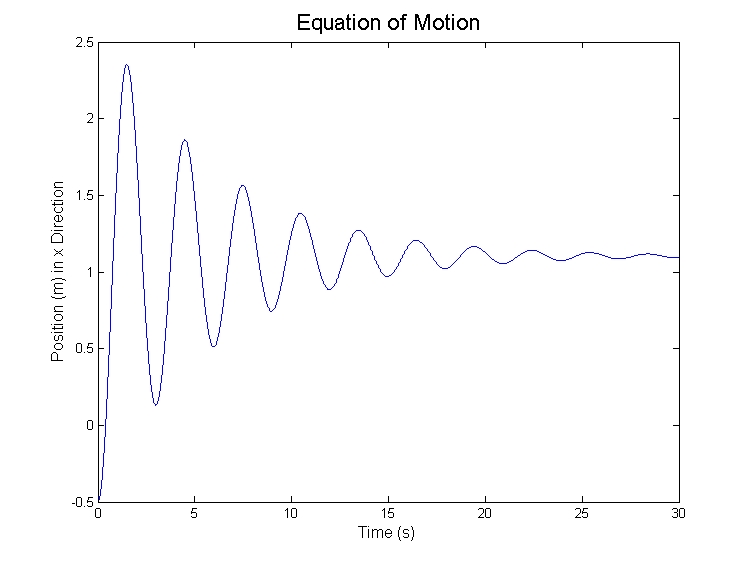
Part 2 - Final and Initial Value Theorems
Initial Value Theorem
As was derived in class, there are two theorems that relate the initial and final values (in this case positions) of the output functions in the t domain with the output function in the s domain. In a case such as this, in which the initial values are given, the initial value theorem is just a check.

Taking the limit of  gives
gives


Final Value Theorem
The Final Value Theorem is a very useful tool that will show what the final value of the output function (as  ), which in this case is the final position of the block. Notice that it is not the unstretched length of the spring (else
), which in this case is the final position of the block. Notice that it is not the unstretched length of the spring (else  ). It is also of interest to note that only the input function comes into play here, as all the others go to zero, and is not dependent on the initial position or velocity.
). It is also of interest to note that only the input function comes into play here, as all the others go to zero, and is not dependent on the initial position or velocity.



Which can be seen in the plot in the section Equation of Motion.
Part 3 - Bode Plot
The bode plot shows useful information about the system we are analyzing. It has only to do with the transfer function, which means that it does not change based upon the input. However, it can show what a given frequency of a harmonic input will do to the output. For my example, it can be seen that at about  there is a rise in the magnitude of the transfer function. If it were hit with a corresponding frequency by an input function, it could have very larg oscillations.
there is a rise in the magnitude of the transfer function. If it were hit with a corresponding frequency by an input function, it could have very larg oscillations.
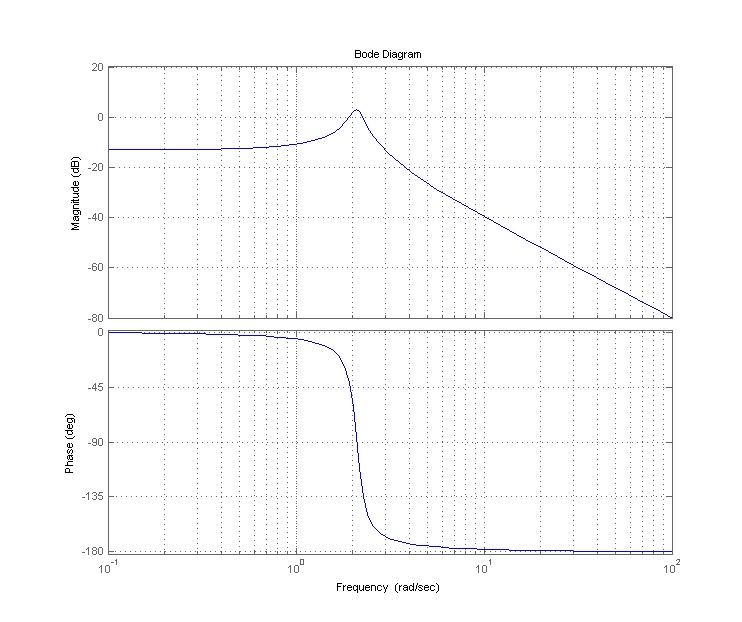
Part 4 - Breakpoints and Asymptotes on Bode Plot
From the transfer function in the Laplace Transform section,

it can be seen that there are no zeros (nothing in the numerator that would make the function go to zero), but there is a place in the denominator that would exhibit deviant behavior. That is when the  and
and  are on the same order of magnitude. That is one stops dominating and the other starts. This point can be visually observed by finding the intersection of the asymptotes in the Bode Plot. Where they intersect is (roughly) a breakpoint. It looks as though this is also the max of the Bode Plot and possibly the resonant frequency.
are on the same order of magnitude. That is one stops dominating and the other starts. This point can be visually observed by finding the intersection of the asymptotes in the Bode Plot. Where they intersect is (roughly) a breakpoint. It looks as though this is also the max of the Bode Plot and possibly the resonant frequency.

Part 5 - Convolution
The convolution is a equation that relates the output to the input and transfer function. As derived in class, it is

Where  is the inverse laplace of the transfer function.
is the inverse laplace of the transfer function.
![{\displaystyle h(t)={\mathcal {L}}^{-1}\left\{{\frac {1}{s^{2}+{\frac {\lambda }{m}}\,s+{\frac {k}{m}}}}\right\}=e^{{\frac {-1}{6}}\,t}\,\left[{\frac {2\,{\sqrt {159}}}{53}}\,\sin {\left({\frac {{\sqrt {159}}\,t}{6}}\right)}\right]}](https://wikimedia.org/api/rest_v1/media/math/render/svg/9cd2433829e18bee2670fa3cdbc11f1276337850)
So
![{\displaystyle x(t)=x_{in}(t)*h(t)=\int _{0}^{t}{\left(g\,\sin {\theta }\right)\,e^{{\frac {-1}{6}}\,\left(t-t_{0}\right)}\,\left[{\frac {2\,{\sqrt {159}}}{53}}\,\sin {\left({\frac {{\sqrt {159}}\,\left(t-t_{0}\right)}{6}}\right)}\right]\,dt_{0}}}](https://wikimedia.org/api/rest_v1/media/math/render/svg/dcb0909b9981d6efcf9850f8c077bcce5a46ca99)
To solve the integral, one must do two integration by parts, or alternatively plug it into a calculator, which yields

As can be seen in the plot, the Convolution method, as executed, resulted in the same results as the Laplace methods, just without any initial conditions (starts at 0 and has a smaller amplitude, but finishes at the same point). Questions left: How could the result be adjusted to account for initial conditions?
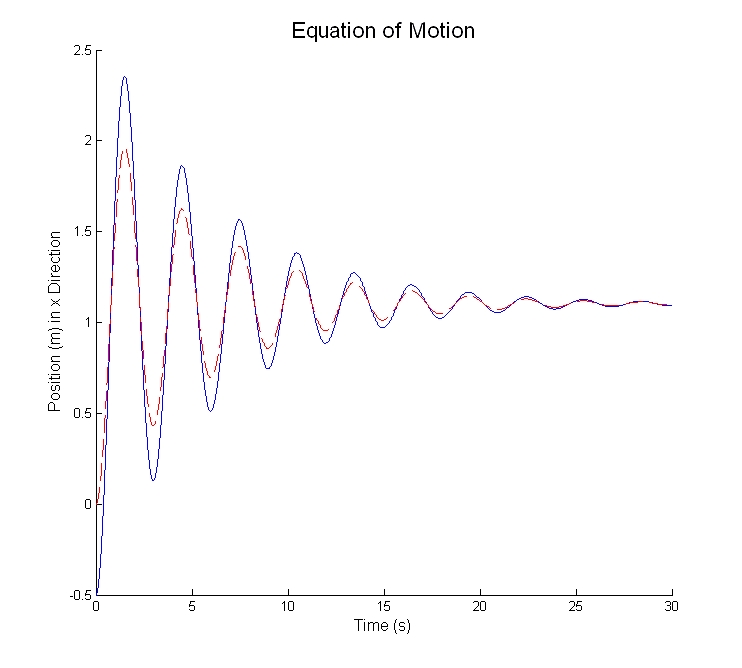
(Laplace in blue solid, Convolution in red dotted)
Part 6 - State Equation
Choose the state variable to be  and
and  , then following the example from class, the state equation is
, then following the example from class, the state equation is

Appendix A
Poles
If one puts the transfer function from the Laplace Transform section, it can be seen that the poles (roots of the denominator) will have both real and imaginary components, which is observable by the quadratic formula

Given
 and
and


Note the (important) switching of the terms in the square root when the  was taken out front, since it is of course
was taken out front, since it is of course  . Below is a nice plot (built in Matlab function, like the bode plot) which the plots poles on the imaginary and real axes. The closer the poles get to the the imaginary axis (i.e., the smaller the real values get), the closer to destructive behavior at a certain frequency.
. Below is a nice plot (built in Matlab function, like the bode plot) which the plots poles on the imaginary and real axes. The closer the poles get to the the imaginary axis (i.e., the smaller the real values get), the closer to destructive behavior at a certain frequency.
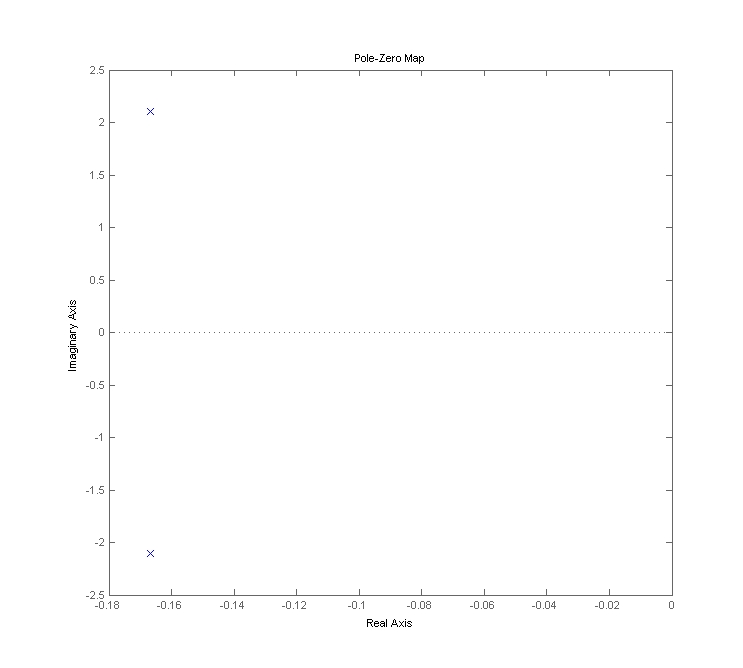










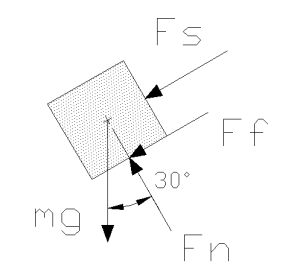















![{\displaystyle {\mathcal {L}}^{-1}\left\{{\frac {1}{s\left(s^{2}+{\frac {\lambda }{m}}\,s+{\frac {k}{m}}\right)}}\right\}=e^{{\frac {-1}{6}}\,t}\,\left[{\frac {-9}{40}}\cos {\left({\frac {{\sqrt {159}}\,t}{6}}\right)}-{\frac {3\,{\sqrt {159}}}{2120}}\,\sin {\left({\frac {{\sqrt {159}}\,t}{6}}\right)}\right]+{\frac {9}{40}}}](https://wikimedia.org/api/rest_v1/media/math/render/svg/ad5b36ffaeed40fa94940fc3806855bf6dfc2c1f)
![{\displaystyle {\mathcal {L}}^{-1}\left\{{\frac {s}{s^{2}+{\frac {\lambda }{m}}\,s+{\frac {k}{m}}}}\right\}=e^{{\frac {-1}{6}}\,t}\,\left[\cos {\left({\frac {{\sqrt {159}}\,t}{6}}\right)}-{\frac {\sqrt {159}}{159}}\,\sin {\left({\frac {{\sqrt {159}}\,t}{6}}\right)}\right]}](https://wikimedia.org/api/rest_v1/media/math/render/svg/d90e51f054b7c54ff4b69ae0633d56cb495a573f)
![{\displaystyle {\mathcal {L}}^{-1}\left\{{\frac {1}{s^{2}+{\frac {\lambda }{m}}\,s+{\frac {k}{m}}}}\right\}=e^{{\frac {-1}{6}}\,t}\,\left[{\frac {2\,{\sqrt {159}}}{53}}\,\sin {\left({\frac {{\sqrt {159}}\,t}{6}}\right)}\right]}](https://wikimedia.org/api/rest_v1/media/math/render/svg/c1731acd225206c4d8f16cfc653ed27c8ff80761)
![{\displaystyle x(t)=g\,\sin {\theta }\,\left(e^{{\frac {-1}{6}}\,t}\,\left[{\frac {-9}{40}}\cos {\left({\frac {{\sqrt {159}}\,t}{6}}\right)}-{\frac {3\,{\sqrt {159}}}{2120}}\,\sin {\left({\frac {{\sqrt {159}}\,t}{6}}\right)}\right]+{\frac {9}{40}}\right)}](https://wikimedia.org/api/rest_v1/media/math/render/svg/97742d1e81092fba2d08f425ab9afaa6994a123f)
![{\displaystyle +\,x(0)\,\left(e^{{\frac {-1}{6}}\,t}\,\left[\cos {\left({\frac {{\sqrt {159}}\,t}{6}}\right)}-{\frac {\sqrt {159}}{159}}\,\sin {\left({\frac {{\sqrt {159}}\,t}{6}}\right)}\right]\right)}](https://wikimedia.org/api/rest_v1/media/math/render/svg/34642856c90fb65543d042f271e79c328bd5ed01)
![{\displaystyle +\left({\dot {x}}(0)+{\frac {\lambda }{m}}\,x(0)\right)\,\left(e^{{\frac {-1}{6}}\,t}\,\left[{\frac {2\,{\sqrt {159}}}{53}}\,\sin {\left({\frac {{\sqrt {159}}\,t}{6}}\right)}\right]\right)}](https://wikimedia.org/api/rest_v1/media/math/render/svg/96d23bac6963eb06bfd0d313ddaaac192b7a152e)




















![{\displaystyle h(t)={\mathcal {L}}^{-1}\left\{{\frac {1}{s^{2}+{\frac {\lambda }{m}}\,s+{\frac {k}{m}}}}\right\}=e^{{\frac {-1}{6}}\,t}\,\left[{\frac {2\,{\sqrt {159}}}{53}}\,\sin {\left({\frac {{\sqrt {159}}\,t}{6}}\right)}\right]}](https://wikimedia.org/api/rest_v1/media/math/render/svg/9cd2433829e18bee2670fa3cdbc11f1276337850)
![{\displaystyle x(t)=x_{in}(t)*h(t)=\int _{0}^{t}{\left(g\,\sin {\theta }\right)\,e^{{\frac {-1}{6}}\,\left(t-t_{0}\right)}\,\left[{\frac {2\,{\sqrt {159}}}{53}}\,\sin {\left({\frac {{\sqrt {159}}\,\left(t-t_{0}\right)}{6}}\right)}\right]\,dt_{0}}}](https://wikimedia.org/api/rest_v1/media/math/render/svg/dcb0909b9981d6efcf9850f8c077bcce5a46ca99)











